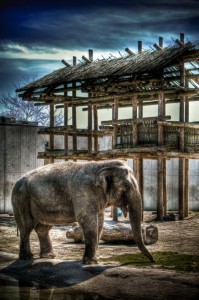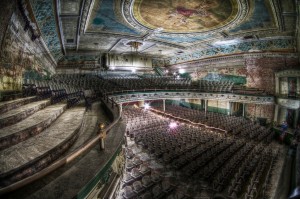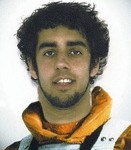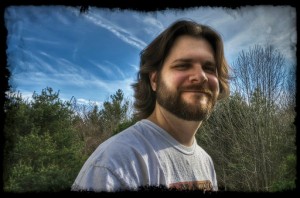New Bedford in a New Light: The Photography of Frank C. Grace
Frank C. Grace is a local man. Born and raised in Fall River, he currently lives in Acushnet with his high school sweetheart Bonnie, who he’s been married to for 18 years, and his six-year-old twin boys, Nathan and Nicholas. He attended UMASS Dartmouth, and after he earned a BS in Textile Chemistry, he continued his education by earning an MS in Color and Polymer Chemistry. He now works as the director of research and development for a textile company in Taunton.
In his spare time Frank enjoys photographing people and places in the South Coast area, but his is not the run-of-the-mill, cell phone photography many of us engage in. While you will recognize the subjects of his photos, they will not be quite how you remember them. His photographs manage to be both familiar and unfamiliar at the same time.
It all started innocently enough with the purchase of a 35mm SLR film camera in 2002. After buying that camera, a Pentax ZX-7, Frank began devouring every book on photography he could get his hands on. He began with books on the basics of photo composition before moving on to exposure and lighting and things of that nature.
As he grew in knowledge and experience, the technology involved grew along with him. This enabled Frank to take what he had been learning about photography and enhance those skills by using a technique called, “high dynamic range imaging,” (HDR for short). Although HDR is not new to the digital camera age (the idea goes back to 1850), the possibilities have expanded exponentially because of it.
Frank started using HDR in late 2009 after reading several tutorials on the subject, though he almost didn’t continue with it because of how software-intensive the process is. To him the learning curve seemed steep, and in the end, he was right:
“Previously, I would take photographs and download them straight to the computer with no ‘post-processing’ at all; it was simple and fast. What helped me overcome this simplistic approach to photography was the look of HDR photographs. They made me feel something, and I wanted to be able to convey those feelings in my photographs.”
HDR works like this: Every digital camera’s sensor captures a range of light, from the brightest source to the darkest. For example, if you have ever taken a photograph on a very bright day where there are just a few clouds in the sky, and the subject of your photos is standing in the shadow of a tree: You end up with a photo where the sky is ‘blown-out’ white, and you lose the detail in the clouds and in the shadows. With a camera, you can never quite capture what your eye can see while you’re there taking the picture because your eye, unlike the camera, can scan a scene and adjust when looking from the sky to the shadows.
This is where HDR can help. In HDR, you take several different exposures of the same scene. An exposure that is overexposed will show the details in the shadows and an exposure that is underexposed will show the details in the brightest areas of a scene. You also take normal, metered exposures, and some others in between.

You then load these exposures onto your computer and into special HDR software (Frank uses HDRSoft Photomatix Pro ) that blends the exposures together to give you detail throughout the image. You can make adjustments to get a photo-realistic effect, or go wild and try for something surreal, or you can land anywhere in between. It all depends how you make the adjustments in the HDR software.
From there, Adobe Photoshop is used to make final adjustments, because according to Frank, the HDR software, “…tends to get you what you want, but also tends to leave an image feeling flat.” Keep in mind that if you are trying to replicate the technique at home, you don’t need to use expensive software like Photoshop; Adobe also has scaled versions like Lightroom or Photoshop Express that will do the job just fine.

Not surprisingly, the surreal, hyper-realistic results of HDR photographs can be very polarizing. Frank has heard it all, from people who admire the work and really enjoy it, to the other end of the spectrum where his work has been called, amongst other things, “clown puke.” Many professional photographers disapprove of the over-the-top processing involved with HDR, and dismiss it as a gimmick. They feel like it takes away from the true art of photography.
Frank, however, views HDR as being akin to effects pedals used by guitarists to create sounds from the guitar that could never be achieved otherwise. It’s a good analogy, though I’m sure nobody referred to “Voodoo Child” as clown puke because Jimi Hendrix used a wah pedal to play it.
So what is it about New Bedford that interests Frank so much? The architecture in the city is what first captured Frank’s attention. New Bedford is still, at its core, an old city; it’s just been updated over time. “You don’t have to know much about the history of the New Bedford to get a feel for it when you walk around downtown,” says Frank. “It is such a New England city. Take a photograph of any structure downtown, be it a city building, shop or art gallery, and include some of the cobblestone street in the shot, and you have yourself a classic New Bedford photograph.”
Frank not only visits New Bedford to take photographs; he is also involved with several organizations in the city. Although he in no way considers himself an artist, Frank is a proud member of New Bedford’s Gallery X. Gallery X is an artist owned and operated, 501(c)(3) non-profit organization community art center that is open to the public free of charge.

He is also the vice president of O.R.P.H. Inc, whose mission is to preserve, restore, protect and adapt the building known as the French Sharpshooters Hall and Orpheum Theatre, located at 1005 Water Street in New Bedford. Frank first got involved in when he was allowed into the Orpheum to photograph the interior of the theatre and saw its haunting beauty and immense potential for the city.
No matter your opinion of his photographs, Frank’s work is unmistakably local. The style of his photography is complemented beautifully by the HDR aspect of the photos, which combine to allow us to view what we know and recognize about New Bedford in a totally new way. Through our own eyes we view New Bedford as a city with a rich history in the midst of a renaissance. Through Frank’s lens we are able to see the past and present together at once, a surreal vision of what is, and what once was.
You can view more of Frank’s work at his website, Trig Photography. You can also visit him and view his work on his Facebook page.
ngg_shortcode_0_placeholder

